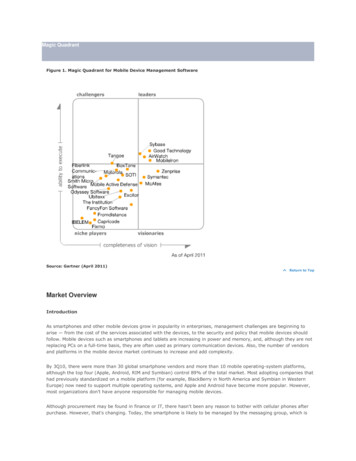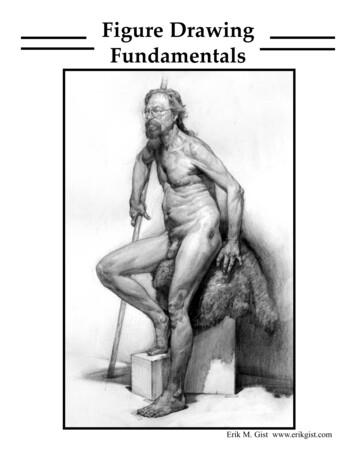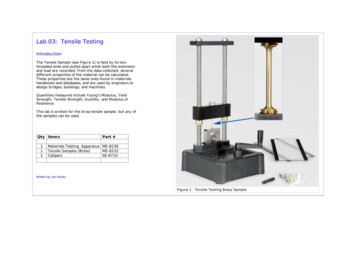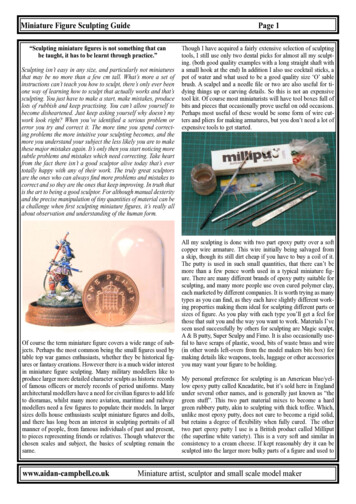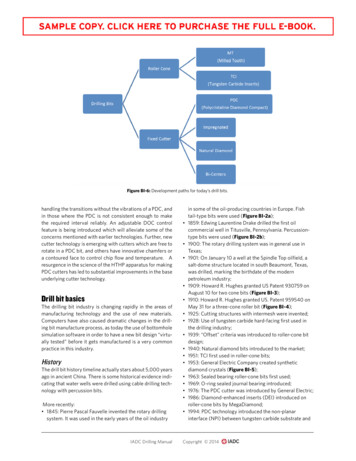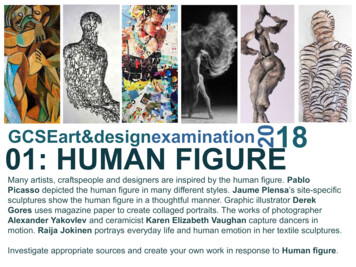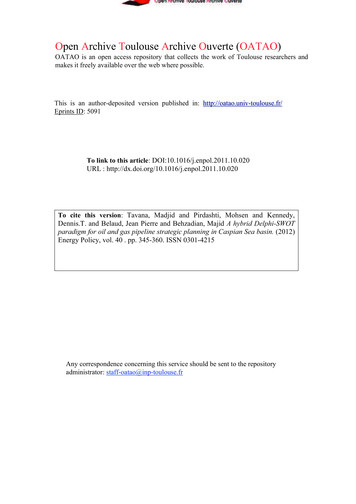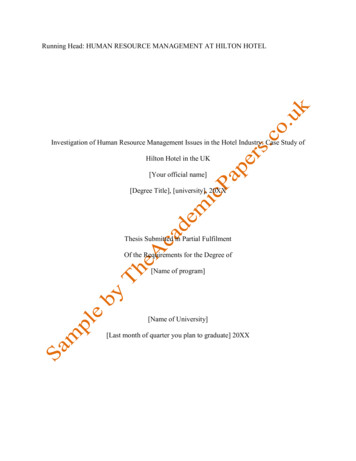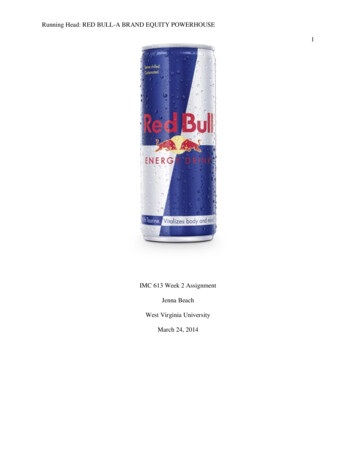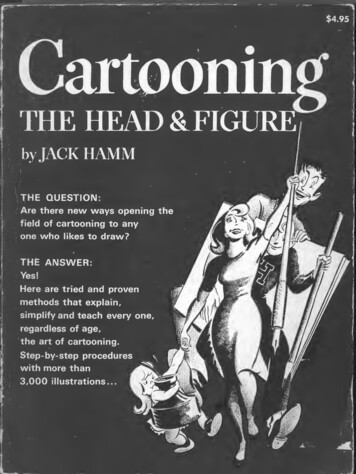
Transcription
4.95THE HEAD & FIGUREby JACK HAMMTHE QUESTION:Are there new ways opening thefield of cartooning to anyone who likes to draw?yTHE ANSWER:Yes!Here are tried and provenmethods that explain,simplify and teach every one,regardless of age,the art of cartooning.Step-by-step procedureswith more than3,000 illustrations.\\
PARTIAL CONTENTS OF "CARTOONING THE HEAD AND FIGURECartoonsketching.nr A1WwmmiA'AIt"'"Hi lull‘diiU.ii/ti
PUBLISHERSGrosset & DunlapNEW YORK
COPYRIGHT 1967BY JACK HAMMALL RIGHTS RESERVED. THIS BOOK, OR PARTS THEREOF,MAYNOTBEREPRODUCEDINANYFORMWITHOUT PERMISSION OF THEPUBLISHERDedicatedtoThe Four Walking Cartoons:Dawna, Charlotte, Monty and Jerry1978 Printingisbn:isbn:0-448-03937-0(library edition)0-448-01541-2(trade edition)library of congress catalog card no.67-14755PRINTED IN THE UNITED STATES OF AMERICA
CONTENTSHighly Stylized Cartoon Girl Heads .The Face and HeadCartoon Faces — In Four Easy Steps . .Simple Yet Profound Facts aboutCartooning.Side and Front View Noses andEyeglasses.: . .Eyes and Brows and Eyes on Side of NoseMouths and Chins.Mustaches, Beards and Ears.Head Shapes and Hair —Male.Hair —Female and Women’s andMen’s Hats.The Profile within the Front View Headand the Partial Profile in the Full Face123456789The Emotions and Facial ExpressionsAnger.Fear.Surprise.Sorrow.Yelling .Worrying, Thinking and Meditating .Smiling — Side and Front View.Laughing — Tongues, Teeth andPlain Openings.Eyelids and Eye Locations(with All Emotions).Alphabetized Catalog of Emotions andExpressions (with Cross References) .Muscles of Expression.1011121314151617181922The Pretty GirlDrawing Pretty Girls.Girl Transition into Cartoon.Types of Girl Cartoon Profiles and aStep-at-a-Time Procedure.Going to Real Life for Cartoon ElementsBreaking Down Faces for Cartoon .More Tips on the Pretty Girl Head .Eight Easy Steps in DrawingTeen-Age Girls.2425262829303132The CaricatureThe Art of Caricature.Helpful Pointers in-Caricature.3334The Standing FigureBuilding Cartoon Figures on theSimple Oval.Beginning the Side View Figure on aTriangle.The Triangle Modified and Reversed andthe Dangling Arm and Jutting Heel .The Front View Figure on a Triangle . .Expanding the Stick Figure.Stepping Outside the Normal into theCartoon World.Usually Cartoon Heads Are Larger,Bodies Smaller.Cartooning on a Hairpin.Drawing the Funny Man.Drawing the Comic Lady.Women’s Fashions and Cartooning .The Side View Female Cartoon.The Front View Female Cartoon .Six Simplified Methods of FemaleConstruction.3536373839404142434445464748The Figure in Different PositionsThe Seated Front View Figure.The Seated Side View Male, Emotions,Sitting, and Sitting with Legs Crossed .The Seated Female.The Kneeling and Bowing Position .Reclining Female Figures.Cartooning Males in Bed — Side View . .Male Recliners — Additional Positions . .49505152535455The Walking FigureThe Walk in Cartoon — Angular andRounded Beginnings.56
Over 150 Side View WalkingCombinations.The Walk Wheel — Over 125 Front ViewWalking Combinations and Leg andFoot Factors.Creating Forward Motion by Perspectiveand Overlap and the Walking FrontView Woman.The Magic of Straights in a Cartoon Walkand the Back View Walk.57586061Notes on Cartooning Little People andPre-set Alphabets.The Cartoon Design.Unusual Effects with a Design Slant .Making Ordinary Objects Come Alive,the Silhouette and the Old-FashionedLook in Cartoon.Costumes of Many Lands in Cartoon . .Animation in Cartoon.878889909192The Baby and ChildThe Running FigureThe Run in Cartoon and theReaching Run.The Desperation Run.Running Figures — in Easy FollowThrough Stages.626364Babies in Cartoon.Tips on Cartooning Babies.Very Young Children.Little Girls and Parents with Children . .Little Boys.9394959697The Sports CartoonThe HandsA Simplified Guide: Eight Basic HandGroups.The Four Shape Treatments in CartoonHands and the Basic Thumbs.Ways of Drawing Cartoon Hands .656667The FeetCartooning Legs and Feet and theCartoon Shoe.70The ClothingCartoon Clothing and Folds.Men’s and Women’s Clothing.7172The Styles and TechniquesBreaking the Chain of Tight ConformityStyle and Technique Possibilities AreUnlimited.The Wandering Pen Line.Aerating a Cartoon.73747677The Editorial and Political CartoonApproaching the Editorial Cartoon .Tips on Editorial Cartooning.Fluoro Wash and Dry Transfer ScreenCartooning.788081The Advertising Application —Newspapers, Magazines, Television, etc.The Commercial Cartoon andAd Eye Catchers.Line Width in a Commercial Cartoon andCartoon Message Bearers.Using Various Papers in theCommercial Cartoon.More Styles and Techniques forAdvertising.Different Techniques Featuring Women .8283848586The Importance of the Sports Cartoonand Simplified Figure Anatomy . 98Putting Muscles on the Stick Figure andAreas of Exaggeration. 99Exaggerating Sports Action.100Putting Thunder in the Sports Cartoon . 101Drawing Sports Personalities.102Sports Spots.103Special ProblemsCartooning Old Age.104Hobos and Tramps.106Low and High Society.107The Heavy Figure.108Pre-historic Characters.109The Military.110Cartooning Total Exhaustion.IllCharacters in Conversation.112People in the Act of Writing.113Speakers and Orators.114Cartooning Special Attire.115Dealing with Various Cartoon Subjects . 116Miscellaneous Situations.117Miscellaneous Characters and Types . 118Drawing Crowds of People.119A Final Word.120
PREFACEWho can imagine a newspaper withouta comic section, an editorial page withouta central cartoon, television without ani mated cartoons, the theater without livelycartoon comedies, magazines and tradepublications without amusing gag panelsor advertising in its endless forms withoutcartoons? Cartoons are playing an everlarger part in today’s world. Within thelast few years multi-million dollar adver tising campaigns have been built around afew simple commercial cartoons. The car toon has become the king in many quar ters, showing no signs at all of abdication.The most natural “cartooners” on theearth are children. They draw cartoonswithout half trying. Occasionally a sea soned cartoonist, for a refreshing change,will return to this natural flare possessedby nearly every child. When even a smallchild is encouraged to take the workablestep-at-a-time procedures, he, along withadults, can make tremendous strides incartooning know-how.There is a universal something in humannature which loves the light touch in mostany given situation. Of all people, the car toonist develops an affinity for this. Ofcourse, eventually it’s not enough just tocartoon a character in the middle of pecu liar circumstances or in an outlandish pre dicament. But being able to do it, and doit well, opens up doors in many rewardingfields and markets.Mankind has passed through many agesand stages, and these changes have madesome professions and lines of work obso lete. However, it is fairly safe to say wewill remain forever in the “Picture Age.”Our accelerated pace of living finds usseizing on pictures which can be graspedin a flash. And, in a world overrun by periland tragedy, humorous pictures are wanted.The relief-bringing cartoon gives us all amuch needed lift.Because cartoons are used in so manyplaces for so many purposes, learning onephase or application helps in all the rest.It is possible to diversify one’s abilities, ashe goes along, so that one’s talents are ingreater demand. This book seeks to fa miliarize the learner not in just one phaseof cartooning nor in just one way of doingit, but in multiple ways and means, stylesand techniques.Another advantage in presenting somany different preliminary steps in all therelated cartoon fields, is that the studentis less likely to become a copyist of some body in particular who already has laidclaim to a single style. Every student haswithin himself the potential to draw like
no one else. Such individuality can best bepromoted by stretching the “drawing mus cles” and expanding the cartoon concepts.The reason for combining the simplest kindof head and figure cartooning with the mostcomplex and advanced is to give the indi vidual cartoonist, regardless of his stage ofdevelopment, that which will be of personalvalue to him in a one-volume package.It should be noted that some modes ofexpression set forth in a specific section ofthis book are applicable in related fields ofcartooning, presented on still other pages.There is no absolute, set, prescribed wayof doing any kind of cartooning. Thereare, however, new lines of approach whichwill in no way deter artistic development,but rather will serve to channel practiceefforts into an enjoyably wide area ofcreativeness.This book was not meant to entertainwith gag lines, jokes and stories. Such en tertainment detracts from the elected pur pose which is to teach the many ramifica tions of head and figure cartooning. Actu ally, there can be more fun in cartoon workthan in most anything a person can do.Help yourself to many interesting periodsof enjoyable exertion. Welcome to the fan tastic land of the cartoon!Jack Hamm
CARTOON FACES—IN FOUR EASY STEPSLet's pull back the curtain from your own latent creativeabilities, provided you are new at this funny business ofcartooning, and introduce you to some whimsical peoplewho perhaps you didn't know could come from your ownpencil.irst, draw any kind of a semi-round enclosure. Whetherit is lop-sided or crooked makes little difference.Next, as a starter, draw a bulb-like nose somewhere inthe central area where we're accustomed to "wearing"this rather vital breathing feature.BlAbove the nose draw spotsor slits for eyes such ashas been done in the stagesnumbered "3” on this page.Beneath the nose draw amouth either smiling (A),indifferent (B), mad (C)or laughing (D).vLetting it go at that, alreadyyou have some funny faces.If you wish to add some "ex tras" like ears, wrinkles inforehead or around mouth,hair, hat or collar and tie,this may be done. See fig ures in the "4" column.There are many people inthis world who have doodledmiles of 'nothing' while talk ing on the phone or killingtime with restless fingers.Why not turn your markingsinto pleasurable and evenprofitable cartooning? It canbe done!1
SIMPLE YET 'PROFOUND' FACTS ABOUT CARTOONINGAt the outset there are several important factors at work on the side of the cartoon student.One is the very positioning of the facial features. To illustrate:Set down four dotsfour dashesand four checks.—** r- *-Anyone can line them up that way. Now, start again with each set; but, instead of making thethird in a row, drop this one below center of the first two. Then make the fourth one belowthe third so that they appear in this arrangement:It is easy to see that the marks which, only a moment before, were simply cold dots, dashesand checks have come to life. Each set has an expression all its own. When these 'faces'are placed inside simple circular shapes, we find we've created several cartoon heads:If a series of the dot, dash or check men were done at random side by side, the viewer wouldreadily notice that the individuals would not look exactly alike but would possess certain 'per sonality differences' :Next, when slight pressures are exerted on the pen, and the act of placing the markings is off hand within the head, pronounced individuality shows up in the 'people' :The foregoing serves to emphasize the fact that shades of expression creep into the simplest offacial features. This is another factor that is a tremendous assist to the cartoonist. Brows andfacial lines about these four features can do much, but some of the greatest cartoons everdrawn have been without them. The ease with which such heads as these can be done should bean encouragement to the beginner. On the following pages the separate facial features are dis cussed and illustrated. It is interesting to 'create' totally new faces by working these and theirvariations in combination. In connection with this study, investigate the various emotions(which follow) that are felt and experienced by man, and learn to incorporate them into the car toon face. The body may react to the emotion — that is why some bodies are included in thesection on emotions — but the emotion in cartoon never escapes the face. Most humor is utter ly dependent upon what transpires in the face. If each head and facial feature on the next sixpages were tried with all the other possible combinations of features presented, mathematical ly the heads would outnumber the population of the world.2
SIDE VIEW CARTOON NOSESA12203456782/ : 40 4/„ O«*& A60616Z E *707977*rA P65 SO8/«az'9S-—96' * * - -89\D 707Z69 «g* SS 8617ZOZZOZ//yZ/7Z8) ()5a 08788zo3 /gy105Z06\19 \ \ \f\54 57 58t?72 38974,Jr 27fb bs p/Hid/55MZ55-9700 ZZ2cr z 48O O98* O////zCr \\\ZA A67686683ifoia, 6ZZCZOS5D - “94„ naa siaaB»’9310 p p ) )28292.7SQV2jeEs! A9pay)Z07*? 0/OS/09/ZOO P O OP OOsmeo*s (CZW222S7/MS )/20 /7/, 3/73/ /As a rule the first thing a cartoonist puts on the face is the nose. It has little to do with expres sion as such, but usually does more in establishing the identity of a character than any other fea ture. In this respect its sameness is as important as the mobility of the eyes and mouth. Varietyin sizes is suggested (above) in repeating in sequence several of the same types. These are notthe only shapes by far, but most types are represented. Joining points of different foreheads andupper lips open up even further possibilities in creating brand new faces./ 4-1015140AA80/7775Ip-''Av'sAInasmuch as nearly any side view cartoon nose may be used on a full front viewface, it is not necessary to show as many front view noses. In fact, many cartoonists use nothing but side view noses on their front (or semi-front) viewfaces. A given side view nose may have its front view counterpart however. Inthis listing (below) one may 'cross' a couple of noses obtaining thereby a stilldifferent n
by JACK HAMM . THE QUESTION: Are there new ways opening the field of cartooning to any one who likes to draw? y . THE ANSWER: Yes! Here are tried and proven methods that explain, simplify and teach every one, regardless of age, the art of cartooning. Step-by-step procedures \\ with more than 3,000 illustrations. "'"Hi lull‘d iiU.ii/ti PARTIAL CONTENTS OF "CARTOONING THE HEAD AND FIGURE .
